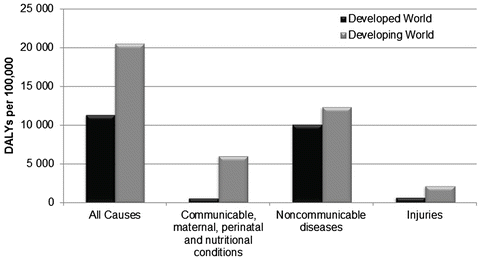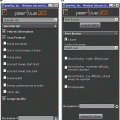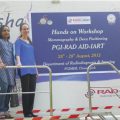(1)
Department of Interventional Radiology, Johns Hopkins Hospital, 1800 Orleans St., Baltimore, MD 21287, USA
Before anything else, preparation is the key to success
Alexander Graham Bell
Introduction
Competently delivered diagnostic and interventional radiology services have become essential components of modern medicine. Patients who entrust their care to hospitals and physicians in the developed world have come to expect access to readily available radiology services. It seems radiology has become so ubiquitous that most of us living in developed nations can scarcely imagine a healthcare system without it. Yet, the World Health Organization (WHO) estimates that somewhere between two-thirds and three-fourths of the global population lacks adequate access to safe, reliable, and competent radiology services [1]. The vast majority of people with limited access to radiology services live in the low- and middle-income nations of the developing world. This disparity in access to radiology services has been termed the “radiology divide” [2–4]. Governments, NGOs, and corporations have tried to address the radiology divide in many parts of the world at various times with varying degrees of success. The approach RAD-AID International has developed is termed Radiology Readiness™. This non-paternalistic, collaborative method is designed to address the radiology divide through a careful, stepwise, and evidence-based approach. The components and implementation of the Radiology Readiness™ approach are discussed in this chapter.
The Radiology Divide
The reasons underlying the radiology divide are numerous and interrelated. However, they can be classified into two broad categories. The first is limited resources. Most developing nations, particularly low-income developing nations, lack the financial and capital resources to invest in what are often expensive radiology development projects. However, even when the financial and capital resources are available, human resources in the form of technical support, maintenance, and trained radiology professionals are often not locally available; this is often the case in middle-income developing countries.
The second broad category underlying the radiology divide is a lack of appropriate device procurement and planning. Unfortunately, well-meaning groups and individuals often bypass the necessary steps required to ensure the sustainability of radiology improvement projects in developing nations. In part, this can be explained by the historically peripheral consideration granted to medical devices during healthcare development projects [1]. According to the WHO:
At present, health care technologies are seen as peripheral to health care delivery and subsequently receive little attention from health care planners. Similarly, donor aid in the form of equipment is seen merely as an addition to the peripheral aspects of health care delivery and seldom as part of an integrated health care plan [1].
In past decades, the primary conditions impacting health in developing nations, including malnutrition, limited access to potable water, and acute infectious diseases, did not require much support from radiology services. However, as the quality of life and access to medical care has increased in these countries, the spectrum of disease has also changed. Today, in the developing world, noncommunicable diseases like heart disease and cancer result in twice as many years of healthy life lost as communicable, maternal, perinatal, and nutritional conditions [5] (Fig. 4.1). These noncommunicable diseases, and chronic infectious diseases like HIV-AIDS and tuberculosis, are best managed when radiology services are available as part of patient care.


Fig. 4.1
Age-standardized disability-adjusted life years (DALYs) per 100,000 adult women stratified by development status. Data was obtained from the World Health Organization Global Burden of Disease summary for 2004 [10]. In the developing world, noncommunicable diseases like heart disease, cancer, and major depression result in twice as many years of healthy life lost as communicable, maternal, perinatal, and nutritional conditions. This is in stark contrast to decades past when noncommunicable diseases were common only in the developed world. The epidemiology of disease in the developing world is rapidly approaching that of the developed world
Careful Assessment and Planning: Radiology Readiness™
Using the combined experience of its members and partners, RAD-AID has developed a streamlined, reproducible approach to helping develop radiology services in developing nation healthcare facilities. Termed “Radiology Readiness™,” this approach assesses existing radiology infrastructure, medical imaging needs, other clinical and diagnostic services, human resources and workflow, and physical, technical, and financial infrastructure prior to designing a development project [2]. According to the WHO, in project planning “The most important pre-requisite… is that the potential recipient truly needs the… equipment and has the expertise and the means to operate and maintain it [1].” This spirit of sustainability is at the heart of the Radiology Readiness™ approach, which has been adopted by the WHO’s Pan-American Health Organization (PAHO) for radiology assessment in its member nations [6].
The evidence-based core of the Radiology Readiness™ approach is a customizable 16-part survey tool. The most recent version of the survey is available on the Internet [7]. The 16 survey sections are listed below:
1.
General and Background Information
2.
Community Involvement and Patient Satis-faction
3.
Clinical Specialties and Disease Epidemiology
4.
Patient Demographics, Capacity, and Referral Patterns
5.
Clinical Tests
6.
Pharmaceutical Agents and Other Clinical Consumables
7.
Human Resources
8.
Training and Continuing Medical Education
9.
Structural, Electrical, Climate Control, and Transportation Infrastructure
10.
Communications
11.
Information Technology
12.
Medical Imaging Capabilities and Limitations
13.
Medical Imaging Device Maintenance
14.
Patient Financial Issues
15.
Financial Infrastructure
16.
Funding of Medical Imaging Services
The individual survey sections can be included or not included in an assessment based on the particular circumstances and needs of the local healthcare facility. For example, the survey section “Medical Imaging Device Maintenance” does not need to be included when evaluating a facility with no existing radiology equipment. The survey should be deployed in a format that allows easy data collection and transfer to a database for later analysis. RAD-AID uses computer- or tablet-based PDF forms with editable data fields. After a survey is completed, data fields can be automatically exported into a spreadsheet or database program.
Stay updated, free articles. Join our Telegram channel

Full access? Get Clinical Tree





